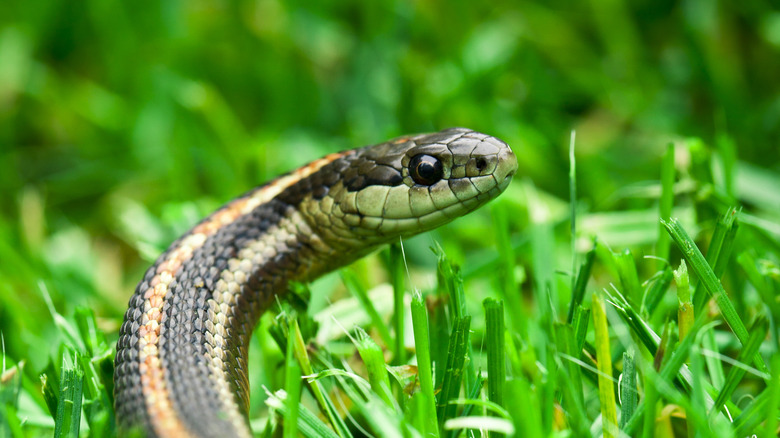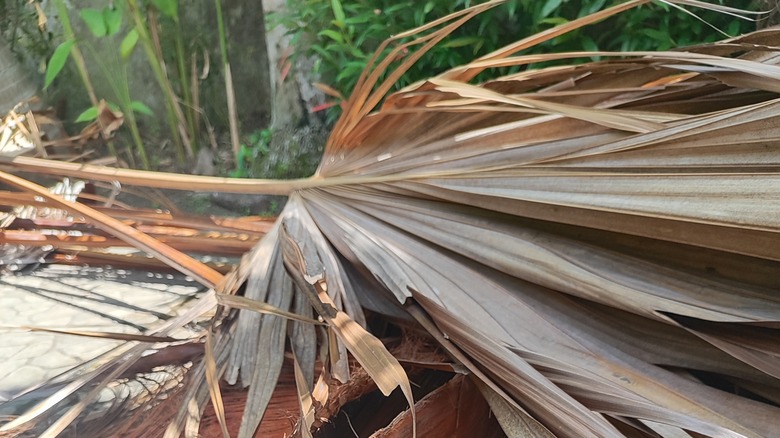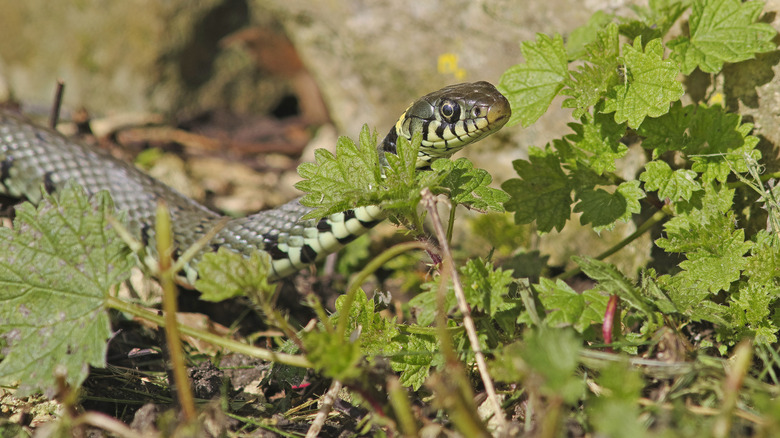The Sneaky Spot Snakes May Be Hiding In Your Yard (And What You Can Do About It)
Even if you've never seen a snake in your yard before, that doesn't mean they haven't been present. Snakes are experts at hiding. In fact, they specifically look for yards that have plenty of hiding spots, and they don't need anything fancy, often taking cover in dead plants. One sneaky spot where snakes like to hide in your yard is in the dead leaves of a palm tree. To eliminate this problem, trim dead palm leaves and get rid of the debris promptly. But be sure to avoid reaching directly for a leaf pile and surprising any possible snakes.
Dead palm leaves aren't the only leaves that snakes like to hide under. They gravitate toward any leaf litter, which is why leaf pile raking can attract snakes to your lawn. Leaves provide a safe hiding spot for snakes, who wait there to protect themselves from potential threats and predators and to watch out for prey. Snakes also seek out shelter to get warm on cold days and cold on hot days; a pile of leaves provides helpful insulation. Similarly, snakes may hide in a number of other cozy spots in your yard, including in tall grass, woodpiles, or even under coiled hoses.
Snake safety during yard clean-up
The majority of snakes in the U.S. aren't venomous and pose no threat to people. There are even some benefits to having a snake or two nearby, as they can help control the population of pests like insects and rodents. However, snakes can be scary. They may attack if surprised or threatened, so it's understandable if you don't want to take any chances.
Be careful when cleaning up dead leaves in case a snake has taken up residence. The key is to avoid catching them off-guard. If they sense you coming, and you give them time to leave, they usually will. You can stomp a bit as you approach, for example, and don't reach in blindly with your hands; gently handle yard debris from a distance with a rake first. This also allows you to check for snakes more thoroughly, as snakes' camouflage can be very effective.
If you see a snake, take a few big steps back. Giving them plenty of space ensures they don't feel threatened enough to attack. Often, all you have to do is simply walk away and wait for it to leave on its own. Don't try to hurt, kill, or move the snake; doing so just puts you at risk of a bite. You can prompt it to leave more quickly by spraying it gently with a hose. If a snake in your yard is too stubborn to leave on its own, call a professional for help with removal.
How to prevent snakes in your yard
To avoid snakes, you need to get rid of their hiding spots and other factors that attract them. Trim away dead leaves and foliage, and remove yard debris right after you're finished working so snakes don't get a chance to hide there in the first place. Since leaf piles are particularly attractive to snakes, if you don't have many trees, you can consider not raking the dead leaves on your lawn and instead opt to leave them spread on the ground as fertilizer. Additionally, eliminate as many other potential hiding spots as possible — for example, keep your grass short and store wood piles indoors or away from your home.
Snakes are also attracted to areas with water and food. Don't water your lawn too much or too often, and fix any puddles or leaks from your plumbing or garden hose. Snakes like to feed on insects and rodents, so by keeping other pests under control and not making mistakes that can attract mice to your garden, you'll also prevent snakes. Luckily, many of the same tactics that deter snakes also deter their prey, like removing yard debris, clutter, and water sources. Additionally, avoid leaving trash or animal food outside (including bird feeders).


